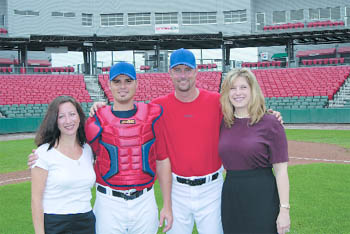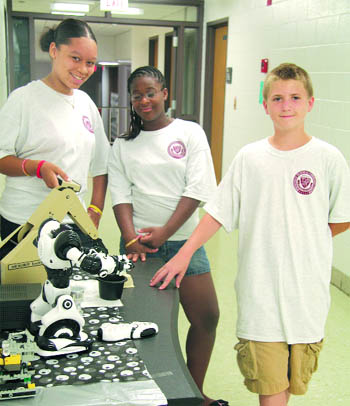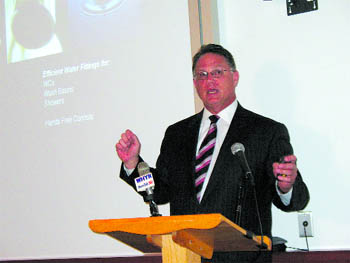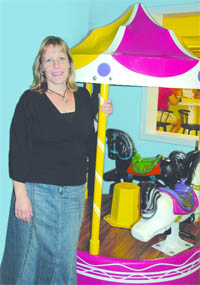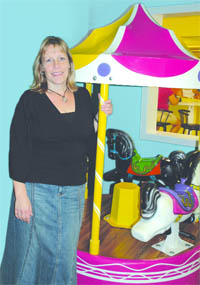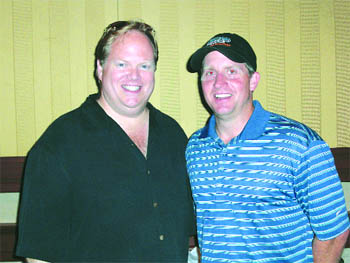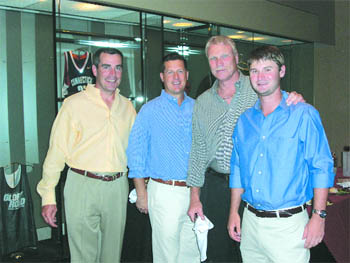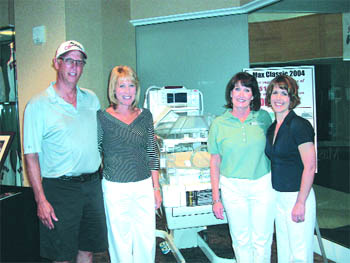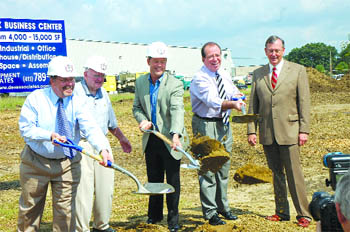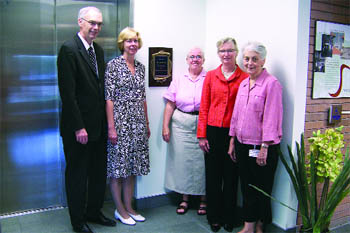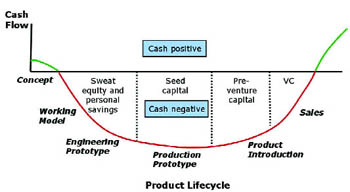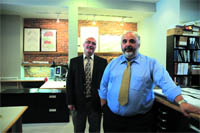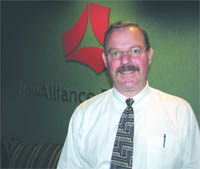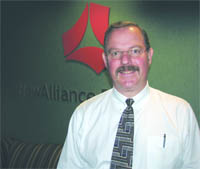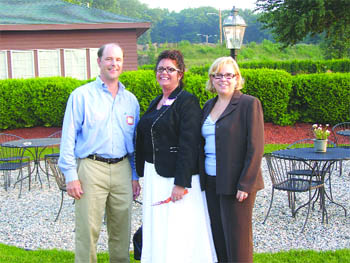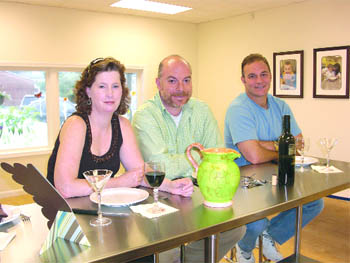Those Driving Diversity Say This Is a Matter Involving Everyone
Visael (Bobby) Rodriguez was exaggerating, but clearly making a point when he said that there are “probably a million” definitions of the word ‘diversity’ being put to use in businesses and organizations across the country.
He has his own.
“Diversity includes everyone; specifically, it is the unique combination of human characteristics of self and others,” he said, quoting from a page of a PowerPoint presentation he uses in his role as the chief diversity officer for Baystate Health, a post he assumed in March. “Diversity is the foundation” — a word he underlines — “of cultural competence.”
And he defines that phrase, as it applies to Baystate, as “the ability of individuals and organizations to effectively understand and address the unique perspectives and health needs of all populations.”
How all this manifests itself varies, he explained, but includes everything from the fact that the information printed on his business card is also in braille to Baystate’s participation this past spring in Northampton’s Gay Pride Parade, a first for the system.
“Diversity looks at embracing differences, and means taking into account the needs of everyone,” said Rodriguez, who must have used that word, and with accompanying emphasis, a dozen times as he spoke with BusinessWest. “This includes males, females, whites, blacks, Hispanics, Moslems, Christians, Jehovah’s Witnesses, lesbians, gays, bisexuals, transgenders, single mothers, people caring for elderly parents … everyone! And it means acknowledging differences.”
Rodriguez is one of a fairly new breed of administrator, at least in this market, the individual charged with not merely defining diversity, but also institutionalizing it and formalizing it within a given organization.
The titles for such employees vary — ‘chief diversity officer,’ ‘global diversity and inclusion executive,’ ‘vice president of Workplace Culture, Diversity, and Compliance,’ and ‘senior vice president and chief people officer’ are among the myriad contrivances now in use across the country — as do the written job descriptions. But their basic mission is the same: to drive diversity, however it may be defined.
And this is not an assignment that amounts to political correctness or just doing the proverbial right thing, said Lorie Valle-Yanez, who was recently named vice president of Diversity and Inclusion at MassMutual. Rather it’s an extremely important strategy for long-term growth, one that touches everything from sales to the supply chain; from employee recruitment and retention to strategic thought processes.
“It’s as much about diversity of thought and perspective as it is about some of the more visible aspects of diversity,” said Valle-Yanez, who came to MassMutual from a similar position at ESPN. “If you’re in a room full of people and there’s visible diversity, you’ll tend to have more diversity of thought, ideas, and perspective — there’s a connection.”
Valle-Yanez told BusinessWest that, as the huge Baby Boom generation enters retirement, corporate America will be faced with replacing tens of millions of workers, and will be fishing in a smaller, historically diverse pool of workers as it goes about that task.
Companies that embrace and effectively exude diversity will thrive in this environment, she said, and those that don’t will likely fare less well.
Greg Michael agreed. He’s the executive director of Human Resources and the Career Center at Western New England College. He told BusinessWest that employers will face two huge challenges in the foreseeable future — attracting qualified talent and then keeping it, at a time when loyalty doesn’t mean what it once did, at least on the employee’s side of the equation.
“The challenge for people in HR over the next five to 10 years is going to be hiring, because the numbers tell us we’re going to lose more people than there will be available to fill the slots,” he explained. “But getting them in the door is only the beginning of the issue. Retention is going to be more and more of an issue; companies have to look at how they’re going to keep people, and one of the ways to do that is to create an environment that is friendly and tolerant.”
In this issue and this focus on business management, BusinessWest looks at how diversity managers will go about creating such environments, and why doing so is simply part of their work to create a ‘diversity strategy.’
Not a Black-and-white Issue
As he talked with BusinessWest, Rodriguez stopped to retrieve the June edition of DiversityInc magazine from his credenza.
This was the annual compilation of the national publication’s “Top 50 Companies for Diversity.” Rodriguez referenced it to help refresh his memory regarding which corporations were at the top of the list — Verizon, Coca-Cola, Pricewaterhouse-Coopers, Procter & Gamble, and Cox Communications were the five highest scorers — but also to point out that the Henry Ford Health System in Detroit was ranked No. 40.
This was the first time that a health care provider had cracked the top 50, said Rodriguez, who told BusinessWest that one of his hard goals is to put Baystate in that position, and within five years.
“That won’t be easy,” he said, noting that many of those on the top-50 list are seemingly permanent fixtures that continue to hone elaborate diversity strategies. “Displacing any of those companies will be difficult.”
But Rodriguez is committed to achieving that goal, and he says the reason isn’t the plaque that comes with the honor or the publicity it will generate. Rather, it’s what achieving that status will mean.
In short, it means the company will have taken some huge steps toward becoming one of those employers of choice that Michael referenced.
And that will be an important designation because, by his count, the Baystate system will have to fill roughly 18,000 positions over roughly the next decade, a figure he arrived at by calculating needs from continued expansion, especially construction of a $250 million addition, the so-called ‘Hospital of the Future,’ and also turnover and replacing retirees.
But cracking the top 50 will also mean the system will be better able to serve the region than it is today, he said, because it will better understand the needs and challenges of the many constituencies that comprise the local population.
As he talked about the work to be done at Baystate, and why he left a similar position at Blue Cross/Blue Shield in Florida to join the system after being recruited by a ‘diversity headhunter’ to interview for the position, Rodriguez used the phrase “starting from scratch.”
He quickly elaborated, noting that, while diversity has long been a matter of discussion and, in many ways, part of the culture at Baystate, the process of formalizing it, or institutionalizing it, is essentially just beginning.
When asked how he will go about that assignment, he said the work will take many forms, but the broad mission is to create a workforce within the system that is what he considers “culturally competent, and that reflects changes in the population.”
And by that, he means a workforce that really understands how various demographic groups are different and is able, in effect, to get inside those worlds.
“Because I have, say, 100 employees who speak Spanish doesn’t mean they’re culturally competent,” he noted. “Cultural competence means acknowledging differences and understanding them; it’s a male acknowledging that a woman is different and that he understand her needs; it’s understanding that Vietnamese women are five times more prone to cervical cancer than American women; it’s understanding that Hispanics comprise 20% of new tuberculosis cases.
“That’s what I mean by cultural competence,” he continued, “and having it will make us a better health care system.”
These are some specific examples of the many ways diversity efforts manifest themselves, he said, adding that his general job description is to make diversity a strategic initiative and not a buzzword.
Policy Shift
In many ways, Valle-Yanez assumed a similar challenge at ESPN, which had no formal diversity programs prior to her arrival, and she’s now doing essentially the same at MassMutual.
She told BusinessWest that the company, which has more than 10,000 employees and financial professionals across the country, has undertaken a number of initiatives in the name of diversity. It will be her job to coordinate all of them and provide more structure.
“MassMutual certainly has many efforts going on with regard to diversity,” she explained. “My job is to hopefully align them all so they’re all pointing in the right direction and we can leverage those efforts; I’m here to put together an integrated strategy.
“It starts with understanding the business and its culture, finding out where the company is, and then putting together a strategy that makes sense culturally to create some forward momentum,” she continued. “A company needs to focus on how diversity and inclusion really help from a business perspective.”
Listing some of the ways it helps, she mentioned recruiting and retaining employees, but said it goes much deeper. It can also help cultivate new customer bases at a time when demographics are changing, in this region and across the country — the term ‘minority majority’ sums up the census numbers in most urban areas.
“Recruiting and retaining talent is a big piece of the diversity pie,” she said, “but it’s also about really serving the diversity of our customer base and reaching new markets that are untapped or currently underserved.”
Summing up her assignment at MassMutual, she said it is to create what she calls a “diverse mindset.” Elaborating, she described this as “an overarching strategy that people can align themselves to.
“This occurs when it starts to really take hold in an organization and becomes part of the culture,” she explained. “Diversity becomes top-of-mind, and people start to think differently … they even think about how to approach their work differently.”
Valle-Yanez could truly be described as a veteran of the diversity movement, if one could call it that. Before joining ESPN, she worked for more than 20 years at the Lawrence Livermore National Laboratory in California, and eventually took the lead diversity role as group leader of the Diversity Programs Office. She is a member of something called the Diversity Collegium, 25-member think tank dedicated to advancing the field of diversity and inclusion.
She said there have been diversity directors on the West Coast for 20 years or more — largely because that area has historically been more culturally diverse — and that she has seen this trend, like many others, move west to east.
Many large companies now have diversity directors and/or departments in place, she explained, and most colleges now have an administrator charged with promoting diversity.
Myra Smith is one of them.
A 30-year employee of Springfield Technical Community College, Smith, who has held several titles at the school, including assistant vice president of Human Resources, was promoted in 2005 to vice president of Human Resources and Multi-cultural Affairs.
One of her first assignments was to create a diversity council. It currently has 27 members from several constituencies, including students, faculty, and staff, and exists not merely to promote diversity but also to celebrate it.
“The council takes a look at all aspects of the campus, to make sure that they properly reflect the diversity that exists here, especially with our students,” she said, mentioning marketing as one area in which the council has generated change to what existed prior to its existence. “We began to make sure that we had more inclusion in the marketing materials that were sent out, in everything from race to age, so they better reflect the people we serve here.”
Not by the Numbers
Smith, like all those who spoke with BusinessWest, said that diversity is often confused with affirmative action when, in reality, it is, or should be, something different and much broader. Corporations and institutions such as colleges must approach their diversity efforts with such a mindset, she added, or they won’t reach their full potential.
Affirmative action is a term that has come to describe a host of often-controversial efforts to increase the representation of women and minorities in areas of employment, education, and business from which they have been historically excluded. Diversity, meanwhile, according those now placed in charge of it, is not about numbers — although numbers are usually a good barometer of whether diversity programs are working, and they are a big part of explaining why companies are Diversity-Inc’s top 50.
“I don’t look at the numbers,” said Smith, adding that diversity, as it has come to be defined, doesn’t mean setting out to create quotas for hiring. Instead, it means creating a broad, inclusive pool of candidates that will, or should, help create a workforce that is diverse and, in the case of STCC, more reflective of the student body it serves.
To achieve this, campuses and companies must be, in a word, “friendly,” or accepting of people who are in some way, or ways, different, said WNEC’s Michael.
“Everybody works for money,” he explained, “but most people choose to work in a place that provides them with qualitative returns on their investment in labor, rather than just monetary returns. Companies have to create feelings of comfort, feelings of belonging — that’s how they’re going to attract talented individuals and generate loyalty.”
Like others we spoke with, Smith said diversity must be a top-down process, with a huge commitment from the CEO that moves throughout an institution. This was what happened at STCC, she explained, noting that President Ira Rubenzahl, who arrived on the campus four years ago, brought with him a firm belief in the importance of diversity and making the campus better reflect its student body.
This commitment was soon adopted by the board of trustees, which moved to create and fund her position.
This role has evolved since then, she said, but it generally involves helping a host of constituencies (especially students and future students) understand what diversity is, incorporate programs to help achieve it, and, in general, help prepare students for a diverse world.
“You’re working to ensure that everyone in your business or your school has a seat at the table, everyone has a voice, and everyone is heard,” she said, explaining the basic role for all diversity directors. “Here, we want to help prepare people to succeed in a global world where you do have all these people at the table. To do that, they need to be knowledgeable and sensitive to various cultures.”
Rodriguez concurred, and referred back to his experiences with Xerox (where he worked before Blue Cross Blue Shield), a company that worked hard to ensure that its teams and divisions were diverse.
“It’s been proven that, when you have a group that reflects differences in people, the thinking process is different, and you bring ideas to the table that can be very innovative,” he explained. “If I have a team that is only white males or white females, you’re going to get the same input — and output. But if you bring a diverse group together, you’re going to get better input and better ideas.”
Diversity efforts come with a price tag, say those we spoke with, and one that is not insignificant.
But rather than a cost, most consider such an expenditure an investment that should, or must, be made.
“It is an investment, and one we see as critical to our mission,” said Paula Dennison, senior vice president of Human Resources at Baystate Health, who worked with other administrators to create a budget for diversity efforts and then hire an experienced veteran in that field such as Rodriguez.
“We need someone with the expertise needed to get us where we want to be,” she explained. “This is an important strategic initiative for us.”
Debra Palermino used similar words to describe the mindset at massMutual, which she serves as vice president of Corporate Human Resources.
“We have a clear mandate from our CEO [Stuart Reese] that this is not just a workforce imperative, it’s a business imperative,” she explained. “This is a long-term business, and we need to understand our demographics; we’re looking to diversify our sales force, diversify our products and the way we bring them to the market, diversify the customer base, and, because we’re doing all this, we have to diversify our workforce.”
The Last Word
Summing up his ultra-broad job description, Rodriguez said his task is to “embed” diversity into everything at Baystate, from hiring to the menu in the cafeteria; from marketing to the supply chain; from community involvement to his business cards.
Only when such a state is reached can a company or institution truly be “culturally competent,” he explained, adding that, while this phrase doesn’t dominate all of those of millions of definitions of diversity, it does his.
And so it might be fair to say that his real job description is to make definitive changes.
